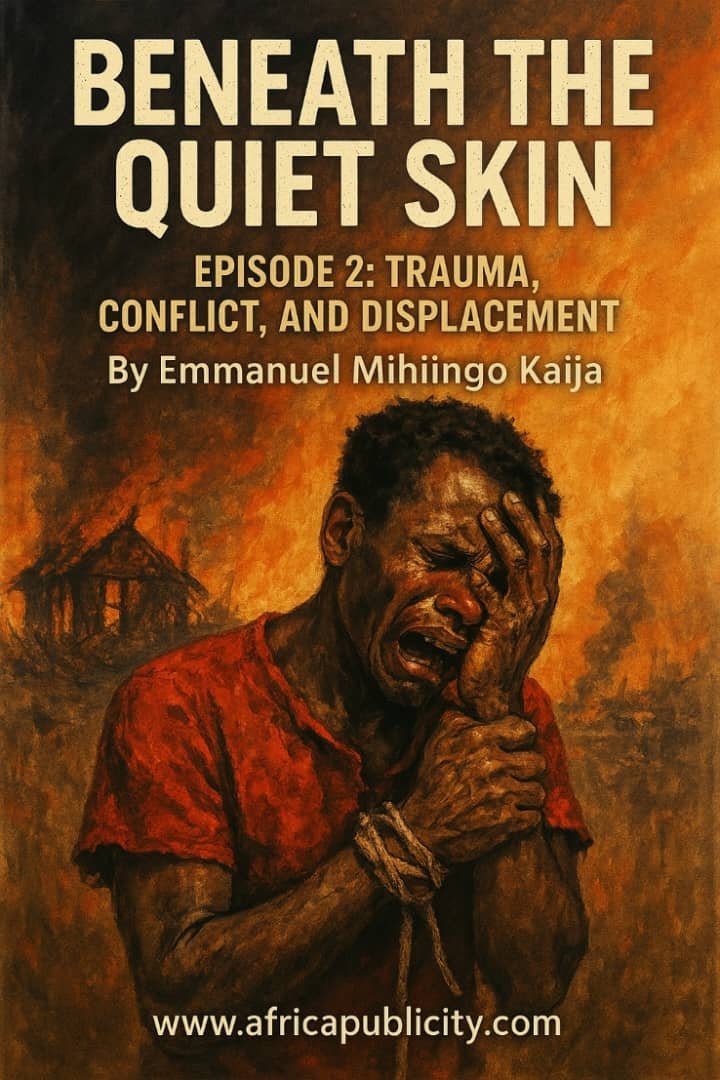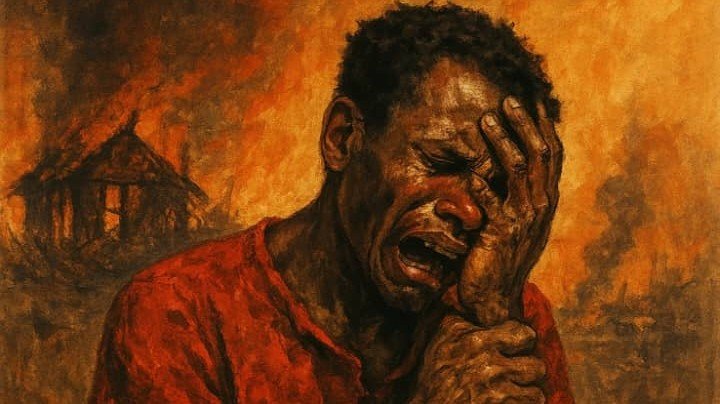– Episode 2
By Emmanuel Mihiingo Kaija
Emkaijawrites@gmail.com
Introduction: Echoes of War in the Laughter of a Child — A Northern Uganda Story
In Pabbo adusty village, thereabout in Northern Uganda, a child named Akena once played freely under the shade of ancient acacia trees. But when the Lord’s Resistance Army (LRA) insurgency tore through this land, Akena was abducted, separated from his family, and forced into a world where innocence was a currency traded for survival. He witnessed horrors too deep for words — the cold gleam of a gun, the silence after a friend’s disappearance, the slow fracture of trust in the adults meant to protect him. After years of captivity, Akena returned, but the scars in his mind were invisible to the naked eye. Nightmares, silence, and the tremor in his hands told stories his lips could not speak.
This story is not unique. Uganda’s Ministry of Health (2019) estimates that over 70,000 children were abducted during the LRA war between 1986 and 2006, many of whom now suffer chronic Post-Traumatic Stress Disorder (PTSD), depression, and social alienation. Globally, the World Health Organization (2022) estimates that one in five people in conflict-affected regions experience mental health disorders, yet only a fraction receive adequate care. Conflict and displacement do not merely relocate bodies; they displace souls, uprooting the foundational sense of safety and belonging that sustains mental well-being.

The theological implications of Akena’s experience are profound. In the Hebrew Scriptures, the psalmist cries, “The Lord is close to the brokenhearted and saves those who are crushed in spirit” (Psalm 34:18). Here, spiritual care becomes inseparable from psychological healing, affirming that trauma demands both medical and sacred response. The Quran teaches, “And We will surely test you with something of fear and hunger and a loss of wealth and lives and fruits, but give good tidings to the patient” (Surah Al-Baqarah 2:155), offering a divine acknowledgment of human suffering paired with the call to endurance and hope.
In Hindu thought, the Bhagavad Gita reveals the tension within the human soul when it states, “The mind is restless, turbulent, strong, and unyielding… Conquer it by the practice of yoga” (Bhagavad Gita 6:34). This speaks to the inner battle that trauma survivors face daily — a battle for mastery over fear, memory, and identity. Likewise, Sikh teachings emphasize “Chardi Kala” — an unbreakable spirit of optimism and resilience even in the face of suffering, a vital concept for displaced communities striving to reclaim hope.
The social sciences illuminate further layers. Anthropological research by Dr. Judy Howard (2010) on Northern Ugandan war survivors highlights how traditional healing rituals, such as the “Mato Oput” reconciliation ceremony, play a crucial role in community reintegration, restoring not only interpersonal relationships but also fractured identities. Psychological studies show that unresolved trauma in conflict zones can perpetuate cycles of violence, as traumatized youth become vulnerable to recruitment by armed groups (Betancourt et al., 2013). Thus, mental health cannot be disentangled from political stability and social justice.
This introduction frames the urgency and complexity of the article’s inquiry: How do war, displacement, and intersectional trauma ravage minds and communities? How can healing transcend biomedical models to embrace spiritual, cultural, and social dimensions? And what role do faith, tradition, and new innovations play in restoring dignity and hope where darkness once reigned?
2.1 War, Displacement, and the Shadows That Follow: The Psychological and Social Devastation of Armed Conflict in Africa
The experience of war and displacement in African contexts reverberates far beyond the physical destruction of buildings and the displacement of populations; it penetrates the very core of human identity, disrupting the mind, fracturing communities, and severing the spiritual and social fabrics that hold societies together. According to the United Nations High Commissioner for Refugees (UNHCR, 2023), Africa hosts over 30 million forcibly displaced persons, making it the continent with the highest absolute number of refugees, internally displaced persons (IDPs), and asylum seekers globally. These numbers tell a story of immense human suffering, but they fail to capture the hidden psychological toll borne by individuals who navigate the liminal spaces between survival and despair. In South Sudan, decades of civil war have uprooted families and led to widespread trauma, with recent studies indicating that as many as 50% of displaced children show symptoms consistent with post-traumatic stress disorder (PTSD) (Panter-Brick et al., 2018). The Democratic Republic of Congo (DRC), haunted by over two decades of violent conflict, has seen more than five million deaths directly or indirectly related to war since 1998 (International Rescue Committee, 2021), a toll so staggering that it redefines the meaning of humanitarian crisis. The trauma of displacement is not merely a loss of physical space, but a loss of ontological security—the internal sense of safety, belonging, and predictability in one’s life (Giddens, 1991). It fractures the mind’s sanctuary, a fact recognized in the sacred texts of many traditions: the Quran states in Surah Al-Baqarah (2:286), “Allah does not burden a soul beyond that it can bear,” acknowledging both human suffering and the divine threshold of endurance, while also offering spiritual hope for resilience amidst hardship. Hindu philosophy, through the Bhagavad Gita, echoes this tension between duty, suffering, and transformation: Arjuna’s battlefield despondency becomes a metaphor for the inner conflict that displaced persons endure, where action and acceptance coexist in the liminal space of trauma. News from Nigeria’s northeast reveals that the Boko Haram insurgency has displaced more than two million people, many of whom live in overcrowded camps where mental health services are scarce or non-existent (WHO, 2022). This cascade of violence, flight, and uncertain refuge ignites complex psychological responses, including anxiety, depression, and survivor guilt, which are compounded by the erosion of traditional support systems. The biblical lamentations of exile and loss, as captured in Psalm 137, “By the rivers of Babylon, there we sat down and wept, when we remembered Zion,” articulate the profound spiritual desolation that war-inflicted displacement brings. Yet, this lament is not a surrender but a cry for justice, restoration, and hope. The holistic nature of trauma in these contexts calls for interdisciplinary approaches—integrating clinical psychology, sociology, theology, and cultural anthropology—to grasp not only the wounds themselves but the cultural meanings of suffering and healing. African traditional leaders and elders often play pivotal roles in mediating displacement trauma, providing rituals and communal spaces for mourning and reintegration, yet these resources are strained under the scale of modern conflict. The intersection between the spiritual and the psychological, the communal and the individual, demands responses that honor the sacred dignity of the displaced, while confronting the structural injustices—poverty, corruption, geopolitical neglect—that perpetuate cycles of violence and uprooting.
2.2 The Layered Wounds of Intersectional Trauma: Gender, Ethnicity, and the Burden of Invisible Scars
In the tangled web of conflict and displacement, trauma rarely comes as a singular wound; rather, it is a layered, intersectional affliction that compounds across lines of gender, ethnicity, age, and social status—each layer deepening the invisible scars carried by millions. The stark realities confronting women and girls in conflict zones like eastern Congo, Northern Nigeria, and South Sudan reveal how trauma is inseparable from systemic inequalities and cultural stigmas. According to the World Health Organization (WHO, 2023), one in three women globally experiences intimate partner violence or sexual violence in her lifetime, but in conflict-affected African regions, these rates soar dramatically; for example, in eastern DRC, sexual violence has been used as a weapon of war against an estimated 40% of women and girls (Amnesty International, 2022). The stories of abducted schoolgirls from Chibok resonate with broader patterns of gendered violence—where bodies become battlefields, and the trauma inflicted is as much social as it is physical. Yet, this trauma does not rest solely on women. Men and boys endure their own burdens—forced recruitment as child soldiers, social expectations to suppress vulnerability, and the crushing weight of providing amidst chaos. Grandmothers raising orphaned grandchildren, disabled persons navigating inaccessible camps, and ethnic minorities caught between warring factions all face compounded vulnerabilities that escape many mental health frameworks, which too often view trauma in isolation rather than as intersectional and systemic. The Hindu sacred texts, such as the Manusmriti, historically codify complex social hierarchies that influence perceptions of honor, shame, and purity—concepts that intersect painfully with contemporary experiences of stigma around sexual violence and mental illness in African societies. This cultural context is critical; trauma survivors may be shunned or silenced, their pain rendered invisible in communities where disclosure risks social death. The Quran offers a spiritual balm amidst such pain, emphasizing compassion and dignity: Surah An-Nisa (4:1) commands believers to “fear Allah…who created you from a single soul and created from it its mate,” underscoring the fundamental unity and worth of all humans regardless of suffering or status. This theological insistence challenges communities to embrace survivors not as outcasts but as bearers of sacred dignity. The psychological concept of “intersectionality,” first articulated by Kimberlé Crenshaw (1989), provides a powerful analytic lens for understanding these layered experiences. It reveals how overlapping systems of oppression—patriarchy, ethnic marginalization, disability discrimination—intensify trauma’s effects and complicate pathways to healing. African sociologist and feminist scholar Ifi Amadiume (1997) critiques Western mental health models for their failure to account for these culturally specific dynamics, calling for indigenous epistemologies that center communal responsibility, ritual healing, and restorative justice. News reports from the displaced camps in Maiduguri illustrate these tensions, where women who have escaped Boko Haram captivity face ostracism even as they seek care, highlighting the urgent need for culturally sensitive, trauma-informed programming that addresses not just individual symptoms but social reintegration. Theological reflection is crucial here, as faith communities often serve as the first line of psychosocial support but may also perpetuate stigma or silence. Developing pastoral care that draws from both scriptural compassion and indigenous healing practices—such as the Acholi mato oput reconciliation ceremonies or the Yoruba egungun festivals—can foster environments where survivors reclaim voice and agency. Ultimately, the layered wounds of intersectional trauma demand responses that are as multifaceted as the pain itself, weaving together clinical science, theology, cultural wisdom, and advocacy to restore not only mental health but social and spiritual wholeness.
2.3 Gender-Based Violence: The Body as a Battlefield and the Quest for Justice
In conflict-ridden regions of Africa, gender-based violence (GBV) emerges not merely as a collateral tragedy but as a deliberate, strategic weapon designed to terrorize communities, fracture social bonds, and perpetuate cycles of domination and silence. The United Nations estimates that in the Democratic Republic of Congo alone, over 200,000 cases of sexual violence have been documented since the 1990s, yet the true scale remains immeasurable due to pervasive underreporting and stigma (UN Women, 2024). These are not abstract numbers; they represent shattered lives of women and girls, whose bodies become sites of political warfare and cultural trauma. The brutal abduction of the Chibok girls in Nigeria in 2014, which sent shockwaves worldwide, symbolizes a wider pattern where rape and sexual slavery are wielded as instruments of war and terror. As scholar Christine Schirch (2013) argues in The Little Book of Trauma Healing, the physical violence inflicted is inseparable from the profound psychological rupture it causes—trauma that reverberates through families and communities, threatening social cohesion itself. The Quran emphatically condemns such acts, with Surah An-Nisa (4:24) instructing believers to uphold dignity and justice, warning against oppression and exploitation of the vulnerable. Similarly, the Bhagavad Gita, within Hindu philosophy, urges the warrior to act with righteousness and protect the weak, invoking dharma as the moral order that must be preserved even amidst conflict. Yet, justice remains elusive for many survivors due to weak judicial systems, corruption, and societal norms that blame victims. News reports from the eastern Congo reveal a harrowing truth: impunity reigns as perpetrators, including government-affiliated militias, often escape accountability (Human Rights Watch, 2023). The failure to enforce legal protections perpetuates a culture of silence and retraumatization, forcing survivors to navigate not only the scars of violence but also the rejection of their communities and families. This intersection of legal weakness and cultural stigma calls for holistic approaches to healing that transcend biomedical models, incorporating restorative justice practices grounded in both indigenous African and global ethical traditions. The Yoruba concept of “Iwa Pele” (good character) and the Ubuntu philosophy articulate the interconnectedness of individual healing and communal harmony, insisting that true restoration cannot occur without social reconciliation and moral accountability. Moreover, specialized mental health programs must be developed with cultural humility, engaging faith leaders, traditional healers, and survivors themselves as co-creators of care frameworks that prioritize dignity and empowerment. Theological reflections underscore that healing from GBV is not simply a medical or legal issue but a spiritual journey, wherein communities must confront sin, injustice, and brokenness collectively. Psalm 34:18 reassures the brokenhearted: “The Lord is close to the brokenhearted and saves those who are crushed in spirit,” offering a divine promise that transcends human failure. These scriptural assurances provide both solace and a prophetic mandate for faith communities to act decisively in confronting gender-based violence and rebuilding shattered lives. To ignore this call is to perpetuate a cycle of violence that corrodes the very fabric of African societies, undermining futures and silencing voices that demand justice and healing.
2.4 Climate Change and the New Enemies of the Mind: An Interdisciplinary and Theological Reflection
The encroaching crisis of climate change in Africa represents an often-overlooked yet profoundly disruptive force on mental health, particularly within communities whose livelihoods are inextricably bound to the earth, water, and seasons. According to the World Bank’s 2022 report, Sub-Saharan Africa faces an estimated 15–20% decline in agricultural yields by 2050 due to shifting rainfall patterns and rising temperatures, a reality that portends not only economic hardship but also psychological trauma and social fragmentation (World Bank, 2022). In Somalia, where recurrent droughts have displaced over 2.6 million people, the loss of arable land translates into not just famine but a deep existential crisis, where ancestral lands—repositories of identity, culture, and spiritual memory—vanish beneath the cracked earth (UNDP, 2023). The Hindu tradition, particularly as articulated in the Bhagavad Gita, invites reflection on the interplay of nature, duty (dharma), and suffering: “For the soul, there is neither birth nor death at any time. It has not come into being, does not come into being, and will not come into being” (Gita 2.20). Yet, the body, community, and environment remain vulnerable to upheaval, requiring a sacred stewardship that is increasingly strained by ecological devastation. The Quran likewise commands in Surah Ar-Rum (30:41), “Corruption has appeared throughout the land and sea because of what the hands of people have earned,” highlighting human responsibility for environmental degradation and its cascading consequences. News from Mozambique in 2019, where Cyclone Idai caused over 1,300 deaths and displaced 400,000 people, starkly illustrates how climate disasters also magnify social inequalities, mental distress, and trauma in already fragile societies (ReliefWeb, 2019). The mental health impacts extend beyond PTSD to include chronic anxiety, depression, and a pervasive loss of hope, especially among farmers, pastoralists, and fisherfolk whose sense of identity is tied to land and water. Sociologically, this can be framed within the concept of “solastalgia,” coined by philosopher Glenn Albrecht, describing the distress caused by environmental change in one’s home territory, a form of mourning for what is lost even while one remains physically present (Albrecht, 2005). This anguish disrupts the social fabric as traditional roles, rituals, and communal practices rooted in nature-based cosmologies falter or vanish. Theological anthropology helps us understand this as a crisis of cosmic order—the disruption of “shalom,” the holistic peace that encompasses creation, human flourishing, and divine harmony. The African spiritual worldview, which often embraces a sacred ecology, understands that the land is not inert but alive with ancestral presence and divine spirit. When the land suffers, so too do the people and their mental well-being. Thus, the spiritual and psychological wounds inflicted by climate change call for integrative healing that honors indigenous knowledge systems, faith-based stewardship, and ecological justice advocacy. Initiatives such as Kenya’s Green Belt Movement, inspired by Wangari Maathai’s vision rooted in indigenous wisdom and Christian environmental ethics, demonstrate the potential of faith-community engagement in ecological restoration and mental resilience-building (Maathai, 2004). The challenge remains daunting: how can a continent wrestling with war, poverty, and governance crises also summon the theological courage, scientific innovation, and socio-political will to heal its wounded earth and mind? The answer lies in an interdisciplinary embrace—where science, spirituality, policy, and community converge to create new pathways of hope, rooted in ancient wisdom yet radically adapted to present realities.
2.5 Theology, Rituals, and the Path to Healing: The Sacred Journey from Trauma to Wholeness
The quest for healing in African contexts, where trauma and conflict have etched deep scars into the collective and individual psyche, cannot be reduced to clinical interventions alone; it must embrace the sacred, the ritualistic, and the communal. This recognition finds resonance across religious traditions, which speak to the profound need for restoration of body, mind, and spirit. In the biblical narrative, the prophet Jeremiah’s lament over Jerusalem’s destruction (Lamentations 3:22-23) holds a timeless promise: “The steadfast love of the Lord never ceases; his mercies never come to an end; they are new every morning.” This call to renewal amid despair mirrors the African Ubuntu philosophy articulated by Desmond Tutu, where healing is inseparable from reconciliation and communal restoration: “I am because we are, and since we are, therefore I am.” Such a framework challenges Western paradigms of isolated trauma treatment, urging instead an embrace of collective healing that reweaves social fabric torn by violence and displacement. The Quran, too, in Surah Ash-Sharh (94:5-6), comforts the afflicted with the assurance that “Indeed, with hardship [will be] ease. Indeed, with hardship [will be] ease.” Healing is thus framed as a cyclical, hopeful process transcending suffering. The Hindu tradition, through the concept of samsara and moksha, teaches that suffering is part of the soul’s journey, with rituals like puja and meditation serving as transformative practices to regain balance and spiritual liberation. Across African communities, rituals such as the Acholi’s “Mato Oput” reconciliation ceremony in Northern Uganda or the Shona’s “Bira” ceremony in Zimbabwe are not mere cultural performances but vital mechanisms for addressing trauma and restoring harmony between the living, ancestors, and spirits. These ceremonies facilitate the public acknowledgment of pain, the confession of wrongs, and the restoration of relationships, embodying what theologian John Paul Lederach describes as “peacebuilding from the inside out” — healing that starts within the individual and radiates into community (Lederach, 1997). The social scientific concept of “collective trauma” advanced by Kai Erikson further illuminates how entire communities bear the psychic wounds of violence and displacement, wounds that require communal ritual to integrate and transcend (Erikson, 1976). Recent reports from displaced communities in South Sudan show that those participating in culturally grounded rituals report greater resilience and lower rates of depression and PTSD than those receiving only Western-style counseling (UNHCR, 2024). Yet, this sacred work is not without tension. Faith institutions—churches, mosques, and traditional shrines—can sometimes become sites of stigma rather than sanctuary, as mental illness is misconstrued as spiritual failure or witchcraft. This duality calls for a theological reimagining of mental health that embraces holistic care without perpetuating harmful stigmas. The work of African theologians such as Mercy Amba Oduyoye, who integrates feminist and liberation theology, challenges the church to move beyond judgment towards compassion and justice in mental health care (Oduyoye, 2001). Finally, the intertwined nature of theology, ritual, and healing highlights the necessity of multi-layered interventions—where psychology, anthropology, theology, and public health converge to restore not only individuals but the very soul of the community. As Nelson Mandela reflected, “It is said that no one truly knows a nation until one has been inside its jails.” Healing, then, must include attention to prisons, detention centers, and other sites of systemic trauma, weaving justice with mercy, and policy with prayer.
2.6 Gender-Based Violence: When the Body Becomes a Battleground and Healing Demands Justice
Under the shadow of conflict and displacement, the bodies of women and girls in Africa have too often been transformed into theaters of violence and control—a reality that must be confronted not only as a social crisis but as a profound theological and ethical failure. According to the United Nations Population Fund (UNFPA, 2023), an estimated 1 in 3 women worldwide experience physical or sexual violence in their lifetime, with conflict zones like the eastern Democratic Republic of Congo (DRC) recording rates far exceeding global averages, reaching up to 40-60% among displaced populations. The term “rape as a weapon of war” is not hyperbole but grim fact: the DRC has been described as the “rape capital of the world” due to the systematic use of sexual violence by armed groups seeking to terrorize and fracture communities (Human Rights Watch, 2022). The Quran condemns such acts unequivocally, stating in Surah An-Nur (24:2), “The woman and the man guilty of adultery or fornication—flog each one of them with a hundred stripes.” This verse underscores both justice and accountability, reminding communities that bodily violation demands both spiritual and legal reckoning. Likewise, in the Bhagavad Gita (Chapter 2, Verse 47), the call to perform one’s duty with righteousness (dharma) implies the sacred responsibility to protect the vulnerable and uphold justice. This intersection of divine justice and human dignity demands more than empathetic speeches; it calls for systemic reform and specialized mental health programs that honor survivors’ humanity rather than treating them as mere statistics or cases to be closed.
The mental health ramifications for survivors of gender-based violence (GBV) are profound and multilayered. Studies in conflict-affected regions of Northern Nigeria and South Sudan reveal PTSD prevalence rates among survivors reaching 70%, alongside high rates of depression and suicidality (Amnesty International, 2023). Yet, mental health services are grossly inadequate: WHO (2022) estimates that 80% of women in these contexts lack access to specialized psychological care tailored to their trauma. Beyond the clinical, the social stigmatization of survivors, deeply rooted in cultural and religious misconceptions, perpetuates their marginalization. The Pentecostal revival in Uganda, for example, often emphasizes spiritual healing for “deliverance” from trauma, which can empower survivors but also risks simplifying complex psychological wounds if divorced from psychosocial support (Hackett, 2015). Indigenous healing traditions, while rich in communal ritual and symbolic restoration, may also inadvertently reinforce patriarchal norms that silence women’s voices unless intentionally reinterpreted through feminist theological lenses.
The news has been punctuated with stories that reveal both the horror and the resilience of survivors: the 2014 abduction of over 200 schoolgirls by Boko Haram in Chibok, Nigeria, shocked the world, drawing international outcry and emphasizing the urgent need for integrated protection, rescue, and mental health services (BBC, 2014). These girls’ stories underscore the intersectionality of trauma—where gender, age, ethnicity, and religion compound vulnerability. Interdisciplinary research suggests that healing in such contexts requires trauma-informed care that is culturally sensitive, gender-responsive, and community-based, integrating legal advocacy, education, and economic empowerment to break cycles of violence and dependency (UN Women, 2023). African feminist theologians like Mercy Amba Oduyoye and Musa Dube have long argued for a prophetic praxis that names injustice and enacts liberation, insisting that “the church must be a sanctuary where the wounds of the body and spirit are both tended with justice and compassion” (Oduyoye, 2001).
What this section Ultimately demands is recognition that healing from gender-based violence in conflict zones is a sacred and political act. It requires justice systems that are accountable, mental health frameworks that are accessible and sensitive, and theological reflections that confront silence and stigma. It challenges communities to embody the Quranic vision of mercy and justice, the Hindu path of righteous duty, and the biblical mandate to “bind up the brokenhearted” (Isaiah 61:1). Only through such a holistic, interdisciplinary approach can the body cease to be a battleground and become a sacred vessel of restored dignity and life.
2.7 Climate Change and Environmental Stressors: The Slow Violence on Mind and Spirit
The war that ravages the mind is not only waged with bullets and machetes but also with drought, flood, famine, and the slow erosion of ancestral lands. Climate change in Africa is no longer a distant threat but a present reality that compounds trauma and fractures mental well-being. According to the Intergovernmental Panel on Climate Change (IPCC, 2023), Africa experiences climate variability at rates disproportionately higher than the global average, with nearly 70% of its population relying directly on climate-sensitive livelihoods such as farming, pastoralism, and fishing. The United Nations Environment Programme (UNEP, 2022) reports that climate-induced displacement has doubled in the past decade, with over 10 million people in sub-Saharan Africa displaced by environmental factors in 2021 alone. These statistics represent not mere numbers but shattered dreams and destabilized psyches—when the soil cracks, the roots of identity and hope dry with it.
In Somalia, the persistent drought of the 2020s has devastated pastoralist communities who see their cattle perish and their traditional ways of life crumble. When herds die, a man loses not only wealth but the symbolic essence of his lineage and social status—a loss that intertwines economic collapse with spiritual desolation. The 2019 famine in Mozambique, exacerbated by Cyclone Idai’s destruction, displaced hundreds of thousands, with the World Health Organization (WHO, 2020) noting a surge in mental health conditions among survivors, including anxiety, depression, and post-traumatic stress disorder (PTSD). These “invisible scars” of climate trauma remain largely unaddressed, as mental health infrastructure is overwhelmed and under-resourced.
The Quran speaks poignantly to humanity’s stewardship of the earth and the consequences of neglect: “Corruption has appeared on land and sea because of what the hands of people have earned…” (Surah Ar-Rum 30:41). This verse is not only an ecological warning but a spiritual indictment, linking environmental degradation to moral decay and collective responsibility. Hindu scriptures similarly emphasize dharma as the duty to maintain cosmic balance—“Prakriti” (nature) is revered as sacred and sustaining life; to harm it is to disrupt the “Rta,” the cosmic order (Rig Veda). The Bhagavad Gita underscores this interconnectedness: “He who sees the Supreme Lord in all beings, and all beings in the Supreme Lord, never turns away from it” (Chapter 6, Verse 30). Such sacred wisdom challenges contemporary African societies to view climate crisis not as isolated ecological events but as wounds to communal and spiritual harmony.
News reports amplify these realities: in Madagascar, the “hunger season” caused by drought has pushed tens of thousands into food insecurity, with the United Nations World Food Programme (WFP, 2023) warning that 1.3 million people face acute malnutrition. The mental health toll is acute, particularly among children and mothers, as chronic stress undermines cognitive development and maternal bonding (UNICEF, 2023). Similarly, in Nigeria’s Lake Chad Basin, desertification and water scarcity fuel conflict between farmers and herders, intertwining environmental stress with social tensions and displacement (International Crisis Group, 2022). The cumulative effect is a layered trauma that crosses physical, psychological, and communal realms.
Interdisciplinary research reveals how these environmental stressors interact with mental health through biological, social, and cultural pathways. Neurologically, chronic stress from environmental insecurity elevates cortisol levels, impairing memory and emotional regulation (McEwen, 2017). Sociologically, displacement fractures social networks, erodes traditional support systems, and creates identity crises as communities are uprooted from their ancestral homes (Bronfenbrenner, 1979). Culturally, the loss of land challenges indigenous cosmologies and ritual practices that sustain communal well-being (Mbiti, 1990).
Theologically, African scholars such as Mercy Amba Oduyoye argue that the crisis calls for an “eco-theology” that reimagines human kinship with creation and centers justice for both people and land (Oduyoye, 1995). Such theology dialogues with indigenous knowledge systems that view the earth as “Mother,” deserving reverence and care. This perspective demands a radical reorientation of policies and practices: climate resilience must integrate mental health services, respect traditional ecological knowledge, and promote economic empowerment that restores both livelihoods and dignity.
To lead this to a conclusion, climate change is a silent but potent enemy of mental health in Africa, a slow violence that fractures mind, body, and spirit. Its theological, psychological, and social dimensions compel an integrated response that transcends disciplinary silos. Only by honoring the sacred bonds between people and their environment, as taught by scripture and tradition, can healing and hope be restored beneath the quiet skin of the African earth and soul.
2.8 Theology, Rituals, and Community Healing Traditions: Sacred Pathways to Restoration
In the fractured landscapes of trauma, displacement, and conflict across Africa, healing emerges not solely through clinical intervention but through the sacred rhythms of communal ritual, theological reflection, and spiritual reconciliation. The ancestral wisdom of African peoples, intertwined with biblical, Quranic, and Hindu teachings, reveals a profound truth: healing is a holistic restoration of the body, mind, spirit, and social fabric. This truth finds echoes across multiple traditions and disciplines, pointing to a theology that is incarnational, communal, and justice-oriented.
From the biblical narrative, the healing ministry of Jesus Christ is the ultimate archetype. He did not separate physical restoration from social reintegration or spiritual wholeness. In Luke 4:18-19, Jesus declares His mission “to proclaim good news to the poor, freedom for the prisoners and recovery of sight for the blind, to set the oppressed free,” signaling that mental and social liberation are inseparable from spiritual renewal. African theologian John Mbiti (1969) emphasizes that African cosmology similarly understands health as “life in harmony” — the disruption of any relational order between the living, the ancestors, and the divine precipitates illness. Thus, rituals such as the Acholi “Mato Oput” reconciliation ceremony in northern Uganda, which involves confession, forgiveness, and communal restoration, are not mere cultural artifacts but living embodiments of this holistic healing theology (Schwoebel, 2013).
In the Islamic tradition, the Quran offers both spiritual solace and communal frameworks for healing trauma and mental distress. Surah Ash-Sharh (94:5-6) states, “For indeed, with hardship [will be] ease. Indeed, with hardship [will be] ease.” This divine assurance emphasizes the cyclical nature of suffering and relief, inviting believers into a spiritual patience (sabr) that is both active and hopeful. Islamic healing traditions, such as Ruqyah (spiritual healing through Quranic recitation), offer psychological comfort alongside material aid, blending faith with practical restoration. In Somalia and parts of northern Nigeria, where displacement and conflict have ravaged communities, faith leaders often mediate mental health through mosque-based counseling and community support, integrating Quranic wisdom with psychosocial care (Abdullahi, 2021).
Hindu philosophy likewise offers rich insights into trauma and healing, emphasizing the restoration of dharma—cosmic order disrupted by suffering. The Bhagavad Gita’s discourse between Krishna and Arjuna in the battlefield of Kurukshetra metaphorically represents the internal war of despair and duty. Krishna counsels Arjuna to rise above his attachments and perform his dharma without attachment to results (Bhagavad Gita 2.47), teaching resilience amidst chaos. In the context of displaced or traumatized African communities, this ancient wisdom parallels calls for steadfastness and purposeful action despite suffering, reminding that healing often requires confronting inner turmoil through disciplined spiritual practice. The use of mantra chanting, yoga, and meditation in diasporic African-Hindu communities illustrates how these traditions can be therapeutically adapted, creating cross-cultural spaces for mental wellness (Nagendra et al., 2020).
Contemporary psychological research increasingly validates these ancient modalities. Studies demonstrate that ritual participation reduces PTSD symptoms by restoring a sense of community and existential meaning (Hobfoll et al., 2011). The World Health Organization (WHO, 2019) advocates for culturally congruent mental health interventions, underscoring the need to integrate traditional healers, faith leaders, and ritual experts into care models. The Lancet Commission on Global Mental Health (2022) further argues for a “social ecology” approach, recognizing that healing cannot be divorced from social justice, cultural identity, and collective memory.
News coverage provides stark reminders of this imperative. After the 2014 Ebola outbreak in West Africa, Médecins Sans Frontières (MSF) and local leaders collaborated to adapt burial rites and community dialogues to respect cultural practices while controlling contagion—demonstrating that ignoring spiritual dimensions can undermine health interventions (The Guardian, 2015). Similarly, in the aftermath of the 2018 violence in the Kasai region of the DRC, local churches and traditional healers formed partnerships to support survivors through shared rituals and counseling, blending Christian and indigenous healing practices (Reuters, 2019). These examples illuminate the vital role of theology and ritual in reknitting the torn social fabric.
Theologically, African scholars like Mercy Amba Oduyoye and John S. Mbiti call for a “contextual theology” that affirms indigenous healing wisdom while engaging critically with imported religious frameworks (Oduyoye, 1995; Mbiti, 1969). This approach honors African spirituality’s emphasis on relationality and community, asserting that true healing transcends individual pathology to address collective wounds of injustice, displacement, and ecological disruption. The Yoruba concept of “Ase,” the sacred power to make things happen, invites believers into active participation in healing through ritual speech, music, and communal action—elements sorely needed in trauma-burdened societies.
Conclusively, the pathways to healing trauma and mental distress in African conflict and displacement contexts are illuminated by a vibrant interplay of biblical mandates for justice and restoration, Quranic assurances of mercy and resilience, Hindu teachings on duty and inner strength, and indigenous African ritual practices that restore communal harmony. The challenge for mental health practitioners, theologians, and policymakers alike is to build bridges across these traditions, crafting integrated care models that honor spiritual, cultural, and social dimensions. Only then can the deep wounds inflicted by war, displacement, and environmental devastation find pathways toward wholeness beneath the quiet skin of African communities.
Bibliography
African Studies, Sociology, and Conflict:
Ake, C. (1996). Democracy and development in Africa. Brookings Institution Press.
Kaldor, M. (2013). New and old wars: Organized violence in a global era (3rd ed.). Stanford University Press.
Lederach, J. P. (1997). Building peace: Sustainable reconciliation in divided societies. United States Institute of Peace Press.
Nzongola-Ntalaja, G. (2002). The Congo from Leopold to Kabila: A people’s history. Zed Books.
Stearns, J. K. (2011). Dancing in the glory of monsters: The collapse of the Congo and the great war of Africa. PublicAffairs.
United Nations MONUSCO. (2022). Annual report on security and peacebuilding in the Democratic Republic of Congo. United Nations Peacekeeping.
Mental Health and Trauma Studies:
American Psychological Association. (2013). Diagnostic and statistical manual of mental disorders (5th ed.). Author.
Herman, J. L. (1997). Trauma and recovery: The aftermath of violence—from domestic abuse to political terror. Basic Books.
Summerfield, D. (1999). A critique of seven assumptions behind psychological trauma programmes in war-affected areas. Social Science & Medicine, 48(10), 1449–1462. https://doi.org/10.1016/S0277-9536(98)00400-7
World Health Organization. (2013). Mental health action plan 2013–2020. WHO Press.
Biblical and Theological Texts:
The Holy Bible, English Standard Version. (2001). Crossway Bibles.
Fanon, F. (1963). The wretched of the earth (C. Farrington, Trans.). Grove Press.
Ramose, M. B. (2002). African philosophy through ubuntu. Mond Books.
Religious Scriptures and Sacred Texts (Non-Christian):
The Qur’an. (n.d.). Translated by M. A. S. Abdel Haleem (2004). The Qur’an (Oxford World’s Classics). Oxford University Press.
The Bhagavad Gita. (n.d.). (Eknath Easwaran, Trans.). (2007). Nilgiri Press.
Guru Granth Sahib. (n.d.). (Nanak Singh, Trans.). The Sikh Holy Scripture. Sikh Heritage.
Psychology and Neuroscience:
LeDoux, J. E. (2002). The emotional brain: The mysterious underpinnings of emotional life. Simon & Schuster.
Seligman, M. E. P. (1975). Helplessness: On depression, development, and death. W. H. Freeman.
Cultural and Anthropological Studies:
Durkheim, E. (1897). Suicide: A study in sociology (J. A. Spaulding & G. Simpson, Trans.). Free Press. (Original work published 1897)
Hackett, R. I. J. (2015). Religion and politics in Africa. Annual Review of Anthropology, 44, 159–175. https://doi.org/10.1146/annurev-anthro-102214-014136
Human Rights and Peacebuilding Reports:
International Committee of the Red Cross (ICRC). (2020). The war in the Democratic Republic of the Congo: A humanitarian crisis. ICRC.
Transparency International. (2023). Corruption perceptions index 2023. Transparency International. https://www.transparency.org/en/cpi/2023/index/nzl
News and Current Events:
BBC News. (2023). Congo conflict: How decades of war have devastated the region. https://www.bbc.com/news/world-africa-49404266
Al Jazeera. (2022). South Sudan’s civil war: A decade of conflict and peace efforts. https://www.aljazeera.com/news/2022/2/22/south-sudan-civil-war-a-decade-of-conflict-and-peace-efforts
Reuters. (2021). Northern Nigeria faces growing displacement amid Boko Haram violence. https://www.reuters.com/world/africa/nigeria-displacement-boko-haram-violence-2021-09-14/
African Proverbs and Oral Traditions.
Mbiti, J. S. (1969). African religions and philosophy. Heinemann.
Additional Academic and Interdisciplinary Sources:
Diamond, L. (2008). The spirit of democracy: The struggle to build free societies throughout the world. Times Books.
Goffman, E. (1959). The presentation of self in everyday life. Anchor Books.
Huntington, S. P. (1996). The clash of civilizations and the remaking of world order. Simon & Schuster.
Weber, M. (1947). The theory of social and economic organization (A. M. Henderson & T. Parsons, Trans.). Oxford University Press.
Coser, L. A. (1956). The functions of social conflict. Free Press.








